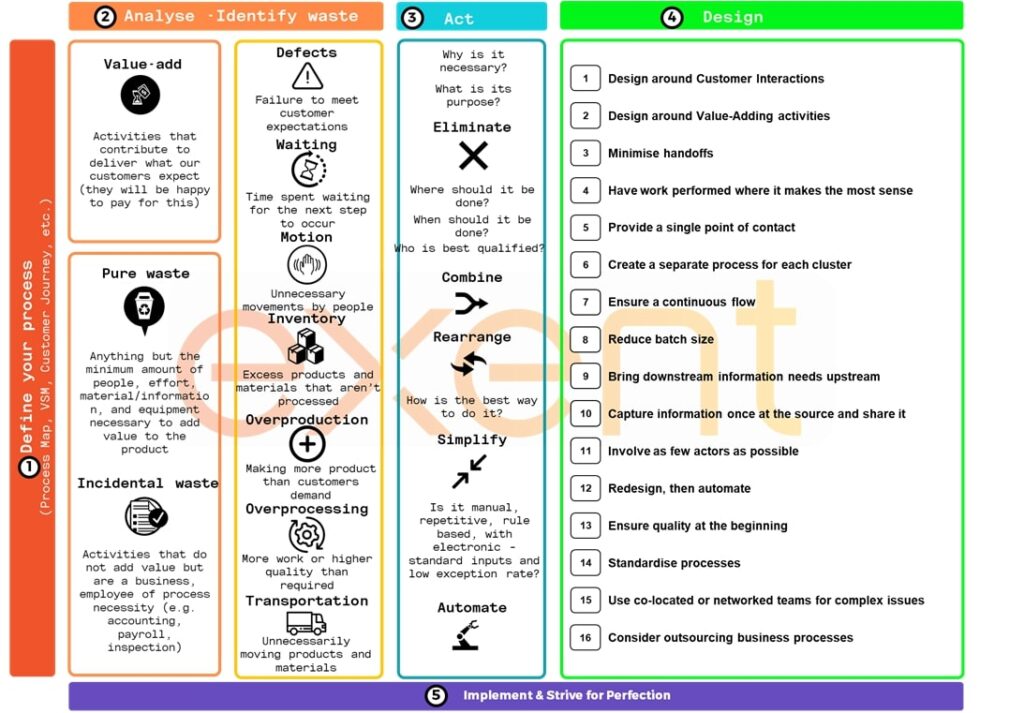Continuous improvement is essential to maintain competitiveness and relevance in today’s market. At the heart of this is the ongoing refinement of business processes. Business Process Improvement (BPI) goes beyond making minor adjustments; it requires a comprehensive reassessment and optimisation of workflows to enhance efficiency, reduce costs, and deliver increased value to customers. This article offers insight into the critical success factors for effective business process improvement.

Overcoming Obstacles
Numerous challenges can impede the improvement of business processes, hindering an organisation’s efforts to streamline operations and optimise efficiency. Understanding and addressing these barriers is crucial to unlocking the full potential of BPI initiatives.
Common hurdles include:
- Lack of clarity regarding objectives and vision
- Short-term focus without ongoing improvement
- Poorly defined process architecture
- Limited resources, including budget and skilled personnel
- Absence of a robust framework for measurement and evaluation
- Inadequate communication and stakeholder engagement
- Resistance to change
How do we overcome these typical obstacles encountered in successful business process improvement?
Unlocking Success in Business Process Improvement
By embracing innovative strategies, leveraging technological advancements, and fostering a culture of continuous improvement, businesses can unlock transformative potential and drive sustainable growth.
The following are key principles, best practices, and actionable insights to empower organisations through business process improvement.
1. Clear Objectives and Vision
Before starting any journey of improvement, it’s essential to have well-defined objectives that align with the overarching business goals, ensuring a strategic approach to BPI.
2. Executive Sponsorship and Support
Securing strong support and sponsorship from executive leadership is crucial. This ensures necessary resources, alignment with strategic goals, and authority to overcome obstacles.
3. Stakeholder Engagement
Active engagement from key stakeholders across departments and levels, fostering a sense of ownership and collective responsibility to ensure full buy-in.
4. Leadership
Leaders provide direction, guidance, and support throughout the process, inspiring teams to embrace change, fostering a culture of innovation and continuous improvement, and ensuring alignment with organisational goals.
5. Data-Driven Decision Making
Leveraging data analysis and metrics to drive decision-making helps pinpoint areas for enhancement with empirical accuracy.
6. Cultivate a Culture of Continuous Improvement
Successful BPI is not a one-time event but rather a continuous journey of refinement and optimisation. It requires ongoing engagement and collaboration among cross-functional teams, involving employees at all levels of the organisation.
7. Seamless Communication
Establishing transparent and fluid communication channels facilitates collaboration across teams and maintains visibility regarding initiatives and their progress.
8. Agility and Adaptability
Maintaining a nimble approach that allows for agile responses to evolving circumstances, enabling swift adjustments and refinements to strategies as needed.
9. Empowerment through Training
Thorough training programs equip employees with the necessary tools and knowledge to embrace process improvements and changes.
10. Commendation of Milestones
Celebrating milestones and successes along the journey of BPI fosters motivation and commitment to ongoing excellence.
The Path to BPI Success
Once the areas for improvement have been identified and the keys to successful BPI are understood, effective deployment execution is crucial for success. For improvements that do not require significant time and resources, it is advisable to use a rapid improvement strategy. This approach focuses on quickly implementing targeted changes to address specific issues or achieve immediate results within a shorter timeframe.
Exent’s Rapid Improvement Approach
This method allows organisations to promptly tackle specific issues or achieve immediate results within a condensed timeframe, making it an effective strategy for timely advancement and swift adaptation to evolving circumstances. By employing a concise 5-step approach, you can enhance your business processes and yield significant benefits.

Approach – LEAN Rapid Improvement
This approach embraces the LEAN methodology, prioritising value-adding activities and eliminating unnecessary steps to streamline processes for optimal results.
1. Define
- Define Value – understand the customer’s value by delving into what the customers are willing to pay for, their perceived value in terms of benefits expected as an outcome, and the usefulness or satisfaction. Determine what a customer would consider value-adding to them.
- Document the Process – utilising the preferred modelling technique, map out all the steps in the process with a subject matter expert. Some commonly used techniques to process model are workshops, interviews or, process observations. Once the process is documented, proceed to validate the output.
- Baseline the performance of the process by capturing the current state process metrics. This can be done reviewing performance data, process observations, subject matter expert input.
For more information on Process Modelling & Techniques, refer to our insights page
2. Analyse
- Classify the process activities by their value utilising the LEAN methodology to determine which activities are value-adding, non-value adding, or essential non-value-adding. This analysis will drill down into each component of each activity to a depth where value is understood.
- Identify waste areas and activities that provide no value. By doing so, this will easily identify the activities within the process that can be streamlined to gain efficiency and better customer outcomes.
For more information on LEAN methodology and waste management, refer to our insights page.
- Identify the improvement opportunities by analysing the waste areas and non-value-adding activities to eliminate, combine, rearrange, simplify, or automate for process optimisation.
- Quantify the benefits utilising process baseline & data-driven insights – if data is unavailable, utilise subject matter expert input and industry data. If assumptions are utilised, provide insights into how assumptions were designed. This step will help identify the opportunities with the most benefit/impact.
3. ACT
- Evaluate the improvement opportunities to inform the future state by categorising the opportunities. Example of how you might categorise:
- Alignment to business plan initiative
- Number of employees impacted
- Dependencies
- Compliance/Risk uplift
- Resources effort
- Benefits
- Complexity
This will draw out the improvement opportunities that are quick wins or have a longer implementation.
- Prioritise and agree with stakeholders on the improvement opportunities for implementation. This is vital to gain buy-in from stakeholders and provide accountability
4. Design
- Process model the future state based on the opportunities
- Benefit Realisation – define the benefit realisation profile for ongoing monitoring
- Change Management Strategy – design the strategy to implement the change and commence wider communication to all stakeholder levels.
5. Implement + Strive for Perfection
- Change Readiness– develop and roll out training for the change initiative. Training can be classroom, virtual, or self-paced learning.
- Knowledge Artifacts – create or update any existing procedural documentation
- Implement the improved process
- Monitor and Control – evaluate the improved process performance and controls utilising the benefit realisation profile. Compare process performance against baseline and projected benefits.
- Seek feedback from process users and key stakeholders for ongoing improvement.
Final Thoughts
The key to successful business process improvement lies in adopting a systematic approach. By following the outlined guiding principles, best practices, and rapid improvement approach, organisations can unlock the full potential of their business processes, drive sustainable improvements, and stay ahead in today’s dynamic and competitive business environment.




